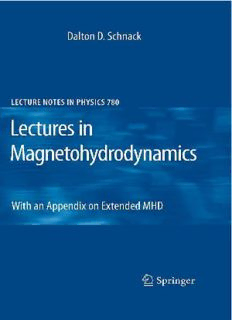Table Of ContentLecture Notes in Physics
FoundingEditors:W.Beiglbo¨ck,J.Ehlers,K.Hepp,H.Weidenmu¨ller
EditorialBoard
R.Beig,Vienna,Austria
W.Beiglbo¨ck,Heidelberg,Germany
W.Domcke,Garching,Germany
B.-G.Englert,Singapore
U.Frisch,Nice,France
F.Guinea,Madrid,Spain
P.Ha¨nggi,Augsburg,Germany
W.Hillebrandt,Garching,Germany
R.L.Jaffe,Cambridge,MA,USA
W.Janke,Leipzig,Germany
H.v.Lo¨hneysen,Karlsruhe,Germany
M.Mangano,Geneva,Switzerland
J.-M.Raimond,Paris,France
D.Sornette,Zurich,Switzerland
S.Theisen,Potsdam,Germany
D.Vollhardt,Augsburg,Germany
W.Weise,Garching,Germany
J.Zittartz,Ko¨ln,Germany
TheLectureNotesinPhysics
TheseriesLectureNotesinPhysics(LNP),foundedin1969,reportsnewdevelopments
in physics research and teaching – quickly and informally, but with a high quality and
theexplicitaimtosummarizeandcommunicatecurrentknowledgeinanaccessibleway.
Bookspublishedinthisseriesareconceivedasbridgingmaterialbetweenadvancedgrad-
uatetextbooksandtheforefrontofresearchandtoservethreepurposes:
• tobeacompactandmodernup-to-datesourceofreferenceonawell-definedtopic
• to serve as an accessible introduction to the field to postgraduate students and
nonspecialistresearchersfromrelatedareas
• tobeasourceofadvancedteachingmaterialforspecializedseminars,coursesand
schools
Both monographs and multi-author volumes will be considered for publication. Edited
volumes should, however, consist of a very limited number of contributions only. Pro-
ceedingswillnotbeconsideredforLNP.
VolumespublishedinLNParedisseminatedbothinprintandinelectronicformats,the
electronicarchivebeingavailableatspringerlink.com.Theseriescontentisindexed,ab-
stractedandreferencedbymanyabstractingandinformationservices,bibliographicnet-
works,subscriptionagencies,librarynetworks,andconsortia.
ProposalsshouldbesenttoamemberoftheEditorialBoard,ordirectlytothemanaging
editoratSpringer:
ChristianCaron
SpringerHeidelberg
PhysicsEditorialDepartmentI
Tiergartenstrasse17
69121Heidelberg/Germany
[email protected]
D.D. Schnack
Lectures
in Magnetohydrodynamics
With an Appendix on Extended MHD
ABC
DaltonD.Schnack
DepartmentPhysics
UniversityofWisconsin
1150UniversityAvenue
MadisonWI53706
USA
[email protected]
Dalton D. Schnack, Lectures in Magnetohydrodynamics: With an Appendix on Extended
MHD,Lect.NotesPhys.780(Springer,BerlinHeidelberg2009),DOI10.1007/978-3-642-
00688-3
ISBN 978-3-642-00687-6 e-ISBN 978-3-642-00688-3
DOI 10.1007/978-3-642-00688-3
SpringerDordrechtHeidelbergLondonNewYork
LectureNotesinPhysicsISSN 0075-8450 e-ISSN 1616-6361
LibraryofCongressControlNumber:2009926863
(cid:2)c Springer-VerlagBerlinHeidelberg2009
Thisworkissubjecttocopyright.Allrightsarereserved,whetherthewholeorpartofthematerialis
concerned,specificallytherightsoftranslation,reprinting,reuseofillustrations,recitation,broadcasting,
reproductiononmicrofilmorinanyotherway,andstorageindatabanks.Duplicationofthispublication
orpartsthereofispermittedonlyundertheprovisionsoftheGermanCopyrightLawofSeptember9,
1965,initscurrentversion,andpermissionforusemustalwaysbeobtainedfromSpringer.Violationsare
liabletoprosecutionundertheGermanCopyrightLaw.
Theuseofgeneraldescriptivenames,registerednames,trademarks,etc.inthispublicationdoesnotimply,
evenintheabsenceofaspecificstatement,thatsuchnamesareexemptfromtherelevantprotectivelaws
andregulationsandthereforefreeforgeneraluse.
Coverdesign:IntegraSoftwareServicePvt.Ltd.
Printedonacid-freepaper
SpringerispartofSpringerScience+BusinessMedia(www.springer.com)
TomyTeachers......
........ ReedRaines,RobertZacur,PeterHavas,HerbJeremias,Ed
Greitzer,George Lamb,Art Mirin, KenMarx,Bill Newcomb,John
Killeen, EdCaramana,RickNebel,DanBarnes,ZoranMikic,Jim
Callen.......
......I hopeto continue tolearn.
And,ofcourse.....
.... toC.K.Rowdyshrub forspiritual enlightenment.
About this Book
This book consists of lecture notes for an advanced graduate course in
magnetohydrodynamics, or MHD, which was taught at the University of Wiscon-
sin, Madison, in the Fall Semester of 2007. It is not a textbook, or a treatise, or
a monograph, or an extended review paper. It is, as advertised, a set of lectures
that were actually given in a classroom setting, presented as close to verbatim as
possible while still being organized and grammatical. The course consisted of 26
classperiodsofanhourandaquartereach.However,thereare38lectures,arranged
bytopic.Someareveryshort,othersmorelengthy.Clearly,anygivenclasssession
mightcovermorethanonetopic,sotheterm“lecture”issomewhatarbitrary.
Therewasnofinalexam.Thegradeswerebasedentirelyonhomeworkproblems
thatwereassignedevery2weeksorsoandgraded.Devisingtheseproblemswasthe
mostdifficultpartofthecourse,andIwasunhappywiththeresults.Ihavetherefore
not included any of them in the present volume. Almost anyone could make up
betterproblemsthanIdid.(Tryityourself!)
The course in MHD is part of a series of one semester core courses required
of plasma physics graduate students at the University of Wisconsin. Others are
Basic Plasma Physics, Fusion Fundamentals, Plasma Kinetic Theory, and Plasma
Waves. With the exception of Basic Plasma Physics, the courses may be taken
in any order, so the instructor cannot assume any specific advanced knowledge
of these fields on the part of the students. Similarly, the students have a variety
ofbackgroundsandinterests.Forexample,intheFallof2007,theMHDclasscon-
sistedof18studentsfromthePhysics,EngineeringPhysics,ElectricalEngineering,
andAstronomy/Astrophysicsdepartments.Theirinterestsvariedaccordingly.Asa
consequence, I tried to present broad a view of MHD, for the most part avoid-
ing diversions into specialized topics and formalisms, such as tokamaks, that are
difficult, time-consuming, and have limitedgeneral interest. Because thestudents’
mathematical backgrounds were also varied, I spent some time reviewing certain
mathematictopics,suchastensors,dyads,matchedasymptoticexpansions,andthe
calculus of variations that are essential to the development of MHD as a topic in
theoretic physics. The goal was to make the course as self-contained as possible.
Theseareincludedinthepresentnotes.
Mostofthematerialinthewrittenlectureswasactuallycoveredintheclassroom.
Ihavenotattemptedto“fleshout”muchofanythinghere.Withafewexceptions,
vii
viii AboutthisBook
ifitisinthenotes,itwassaidinclass.Conversely, thelecturesintentionally omit
someofthegrindingdetailsthataccompanycertainderivations.Thisisespecially
true with respect to some of the material regarding the energy principle, resistive
instabilities,andMHDturbulence,andthisisnotedinthetext.Inalmostallother
cases I tried to present as many of the relevant details as possible. I strived for a
reasonablebalancegiventhetimeavailableforpresentation.Becausethescopeof
thematerialistailoredtothetimeconstraintofa13-weeksemester,thelecturescan
provide the basis for other courses in MHD. Of course, instructors are free to add
ordeletematerial;inparticular,theymightwanttoinventsomeproblemsets!
The notes contained in the present volume have been slightly revised from the
notesthatweredistributedtothestudents.Ihaveaddedsomefootnotesreferencing
source material and corrected some errors that have been brought to my attention.
Ihavealsoaddedashortquotationatthebeginningofeachlecture,whichismeant
to refer (hopefully in a pithy, entertaining way) to some aspect of the material to
be presented. In doing this I was inspired by the famous book by Lord and Lady
Jeffreys.1 They were, however, true scholars who were well educated in classical
literature.Incontrast,IfoundmostofmyquotesonGoogle!Ihopeyoufindthem
at least interesting, and hopefully entertaining, because there’s little enough enter-
tainmentvalueinMHD.Ofcourse,youareinvitedtoprovideyourown,alternative
versions!
I have also included an Appendix on extended MHD. This material was con-
tained in three lectures that I gave at UW inApril, 2006. It talks about the kinetic
theoryunderlyingtheMHDmodel,andhowpeoplehavetriedtoextendthemodel
toincludeadditionalphysicaleffects.Itisself-contained.
The Lectures on Turbulence (36) and Dynamos (38) have benefited from thor-
ough and critical reading by Drs. Paul Terry, Fausto Cattaneo, and Ellen Zweibel.
Their constructive comments and suggestions have greatly improved the presenta-
tion.Asintherestofthebook,anyerrorsthatremain,eitherfactualorinterpretive,
aremyresponsibility.
I also wish to acknowledge Dr. Christian Caron and Ms. Gabriele Hukuba of
Springer-Verlagforalltheirassistanceandsupportinthepublicationprocess.
IwaspartiallysupportedbyseveralgrantsfromtheU.S.DepartmentofEnergy
duringthepreparationofthisbook.
Ihopeyouenjoythelectures,andmaybeevengetsomethingfromthem!
Madison,WI DaltonD.Schnack
1HaroldJeffreysandBerthaJeffreys,MethodsofMathematicalPhysics,CambridgeUniversity
Press,Cambridge(1972).
Preface
Magnetohydrodynamics, or MHD, is a theoretical way of describing the statics
and dynamics of electrically conducting fluids. The most important of these fluids
occurringinbothnatureandthelaboratoryareionizedgases,calledplasmas.These
have the simultaneous properties of conducting electricity and being electrically
chargeneutralonalmostalllengthscales.Thestudyofthesegasesiscalledplasma
physics.
MHD is the poor cousin of plasma physics. It is the simplest theory of plasma
dynamics. In most introductory courses, it is usually afforded a short chapter or
lecture at most: Alfve´n waves, the kink mode, and that is it. (Now, on to Landau
damping!)Inadvancedplasmacourses,suchasthosedealingwithwavesorkinetic
theory, it is given an even more cursory treatment, a brief mention on the way to
thingsmoreprofoundandinteresting.(ItisjustMHD!Besides,realplasmaphysi-
cistsdokinetictheory!)
Nonetheless,MHDisanindispensabletoolinallapplicationsofplasmaphysics.
Eventhesimplestexperimentwillnotbebuiltunlessithasfirstpassedmusterwith
MHD.ThereasonisthatMHDdealswithfundamentalforcebalanceanddeviation
fromit,conceptsthataresurprisinglysubtleandcomplex.MHDalsoprovidesthe
machineryforunderstandingthebasicpropertiesofglobalstructureofmagnetized
plasmas, how they can sustain themselves, and why they share a small number of
global properties. In this course we will look at many of these important issues in
whatIhopeissufficientdetailastorevealsomeoftheelegancethatunderliesthis
immenselyusefultheory,andgainsomeappreciationfortheskillofthepioneersof
thefield.
While MHD is the simplest mathematical model of a plasma, it is difficult to
justify as a valid description of any interesting plasma. Surely plasmas know that
they are made of individual ions and electrons (or at a minimum of separate ion
and electron fluids) and that they are so hot that collisions between particles are
relativelyrareevents!MHDcompletelyignoresbothoftheseissues.Nonetheless,it
isafactthatMHDprovidesaremarkablyaccuratedescriptionofthelow-frequency,
long-wavelength dynamics of real plasmas. MHD seems to work (even when it
shouldn’t)!
ix
Description:This concise and self-contained primer is based on class-tested notes for an advanced graduate course in MHD. The broad areas chosen for presentation are the derivation and properties of the fundamental equations, equilibrium, waves and instabilities, self-organization, turbulence, and dynamos. The

